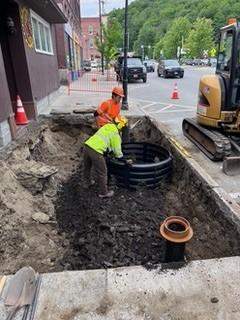June 27, 2024

The latest tool in Montpelier’s urban forestry tool box is the Stockholm solution and it can be significantly more cost effective than other commercial soil cell systems (VTdigger recently did this feature). Alec Ellsworth, Montpelier’s director of Parks and Trees, has provided the cost breakdown for this technique for those interested in considering it as an option for downtown trees.
Urban environments in Vermont are vital for human needs, offering food markets, government services, transportation hubs, and social spaces. Rural residents venture into urban areas for social, cultural, and professional reasons. Urban trees significantly enhance these environments. While it is possible to put a dollar value on the benefits provided by trees in terms of savings in energy costs to cool and heat buildings, air quality related illness reduction, increased economic activity in retail settings, and decreased traffic speeds (therefore fewer accidents), these savings are less tangible than other priorities.
The bottom line is that urban trees provide more benefits than you can shake a stick at, and they make urban spaces more functional. Municipalities however, owe it to their residents to make the most of their budgets, by avoiding unnecessary expenses while maximizing the public good. So cost matters.
Montpelier has been exploring and utilizing the Stockholm solution for downtown trees for several years, with six installations to date. This month, two Main Street Trees were installed using the technique at a of cost to the City of Montpelier of $25,207.13, with the iron grates and guards being the largest expense. This breaks down to $12,603 per tree and soil cell. City of Montpelier staff were able to complete the installation in-house, without needing to hire a contractor. In contrast, a recent estimate for the cost of installing sidewalk trees in soil cells in downtown Burlington was $25,000 per tree using a more widely recognized commercial modular soil cell system.
Further savings are still possible. Installing the trees and soil cell systems with other planned sidewalk work and construction could reduce material and labor costs. Using bareroot trees instead of balled and burlapped nursery stock could provide significant savings on plant material, and alternatives to the iron grates and guards could be seen as an opportunity for local metal fabrication companies to innovate. And practice makes perfect! The more experienced a town and its municipal staff becomes with the method, the more can be saved on labor.
If you are still skeptical about the Stockholm solution, wait a few years to see if the Montpelier trees survive like the ones planted in 2021 have, and then, following Montpelier’s example, give it a try and see for yourself.
Written by VT UCF's Urban Forester, Adam McCullough
Photo credit to John Snell, Montpelier Tree Board